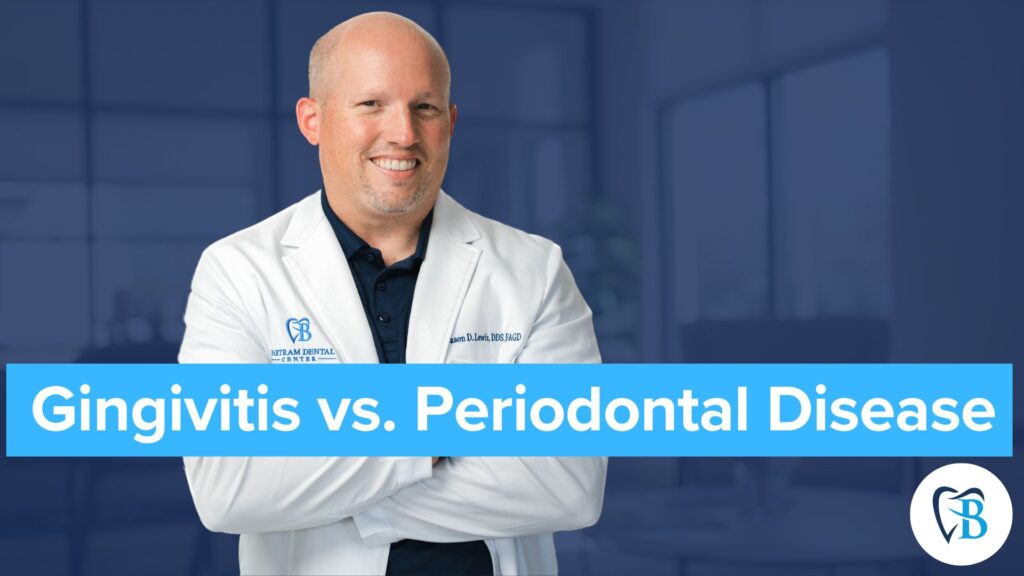Gum disease is an umbrella term for common oral health issues that impact millions of individuals around the world. It’s a broad term that encapsulates several conditions impacting the health of the gums. The two main forms of gum disease are gingivitis and periodontal disease. They might sound alike, but there are substantial differences between them.
Gingivitis is the milder version of gum disease, characterized by inflammation of the gum tissue. It’s usually the result of poor oral hygiene that allows plaque—a sticky film of bacteria—to build up on the teeth and gums. Though gingivitis is not to be taken lightly, it’s reversible with good oral care habits.
Periodontal disease refers to a more severe form of gum disease. If gingivitis is left untreated, it can evolve into this condition. The inflammation spreads beyond the gums, affecting the bones and tissues that support the teeth. It can result in tooth loss and can contribute to other health problems as well.
Gingivitis and Periodontal Disease: The Connection
Despite their differences, gingivitis and periodontal disease are closely linked. The milder form, gingivitis, can progress into the more severe periodontal disease if proper treatment and prevention measures are not followed. Gingivitis should not be seen as an isolated issue but rather a precursor to potentially more serious oral health problems.
Understanding this progression is crucial for everyone. It reinforces the need to pay attention to any changes in oral health, no matter how minor they may seem. Gingivitis, as mild as it is, serves as an initial warning sign that oral health care needs more attention.
This connection between gingivitis and periodontal disease also underscores the importance of professional dental care. Regular dental visits allow for early detection and treatment of gingivitis before it escalates into periodontal disease. The line between these two conditions, although distinctive, can blur without proper oral hygiene and professional care.
Recognizing the Symptoms
Identifying gum disease early can spare individuals from severe health consequences. Unfortunately, early stages might be painless, causing many people to overlook the signs. Yet, paying close attention to changes in oral health could make all the difference.
Gingivitis is typically marked by red, swollen gums that easily bleed, especially when brushing or flossing. It can also cause bad breath and changes in the way teeth fit together. The important fact to remember is that at this stage, the damage is still reversible.
Some other symptoms that might indicate gingivitis also include:
- Gums that are an unusual shade of red, such as dusky or dark
- Swollen gums
- Gums that recede away from the teeth
- Tenderness
On the other hand, periodontal disease presents more severe symptoms. It often causes gums to pull away from the teeth, creating pockets where bacteria can accumulate. As the disease progresses, teeth may become loose or move around in the mouth. In the most advanced cases, tooth loss is possible.
There are also other symptoms of periodontal disease to look for, such as:
- Bad breath that does not go away, even with brushing your teeth
- Pain when biting or chewing food
- Sensitive teeth
If you notice any of the above symptoms for gingivitis or periodontal disease, schedule an appointment with your dentist as soon as possible. The earlier the condition can be treated, the better you can prevent gingivitis developing into periodontal disease or tooth loss from periodontal disease.
Causes and Risk Factors
Gum disease is primarily caused by plaque accumulation due to poor oral hygiene. However, some particular risk factors can increase the likelihood of developing gingivitis or periodontal disease. Understanding these factors helps in maintaining a proactive approach toward oral health.
Smoking poses a significant risk factor for developing gum disease. It affects the healthy function of gum tissue cells, making it easier for an infection to take hold. Additionally, smoking hampers the healing process once gum damage has occurred.
Diabetes is another condition closely associated with gum disease. High blood sugar levels impact the body’s ability to deal with infections, including gum infections. Other risk factors include stress, poor nutrition, and certain medications.
If you smoke, are living with a chronic health condition or take a certain medication that could impact the health of your gums, you should inform your dentist of these potential risk factors. They can more closely monitor the health of your gums and take proactive measures to help prevent or minimize the impact.
Diagnosis and Treatment
Diagnosis of gum diseases usually begins with a regular dental check-up. Dentists use specialized tools, such as a periodontal probe, to detect and measure any pockets that may have formed around the teeth. In certain cases, X-rays may also be necessary to evaluate the health of the bone beneath the gum line.
Once a diagnosis is confirmed, the treatment for gingivitis primarily involves professional dental cleaning and an improved home care routine. Dental cleaning aids in the removal of accumulated plaque and tartar, thereby reducing inflammation. An enhanced home care routine following the cleaning helps maintain a plaque-free environment, preventing the recurrence of gingivitis.
The treatment for periodontal disease is more intensive due to the extent of damage involved. More advanced cleaning procedures, like scaling and root planning, are typically conducted to remove plaque and tartar from deep gum pockets. In certain severe cases, surgical interventions may be needed to reduce pocket depths, making it easier to clean and maintain gum health.
Regardless of the type of treatment, the ultimate goal is to control the infection and halt the progression of the disease.
Prevention Strategies
Preventing gum disease largely rests on the cornerstone of good oral hygiene practices. Consistent brushing and flossing, complemented by the use of antimicrobial mouthwash and waterpik usage, form the first line of defense against plaque buildup. These simple yet effective routines are essential in maintaining healthy gums and teeth.
The bacteria in our mouths directly affect our gum health. This same bacteria has been linked to other serious conditions such as heart attacks, stroke, dementia, and other inflammatory issues. When you’re caring for your gums, you’re also caring for the rest of your body.
Lifestyle choices also play a significant role in gum disease prevention. Smoking, for instance, greatly increases the risk of developing gum disease. Consequently, abstaining from tobacco use is highly recommended for those aiming to maintain good oral health.
Further to this, maintaining a well-balanced diet is highly beneficial. Foods rich in vitamins C and E can boost the body’s resistance against infections, including those that cause gum disease.
Additionally, whenever possible, reduce or eliminate sugar from your diet to protect your gums’ health. Sugary and acidic foods can promote bacterial growth in the mouth. That does not mean you can’t enjoy some of your favorite sweets on occasion, but as with any food, moderation is key.
Get Treatment for Gingivitis and Periodontal Disease in St. Johns, FL
While gingivitis and periodontal disease fall under the umbrella term of gum disease, they differ in their severity, symptoms, and treatment approaches. Understanding these differences and practicing good oral hygiene can help prevent these conditions, along with regular dental check-ups and cleanings.
At Bartram Dental, we view the mouth, teeth, and gums as the gateway to your overall health. With this in mind, we strive to provide the most comprehensive range of dental treatments to our neighbors in St. Johns and the greater Jacksonville area.
If you are experiencing gum health issues or you want to prevent them, treatment starts with a dental appointment. Contact us today to learn more or to schedule a visit.



